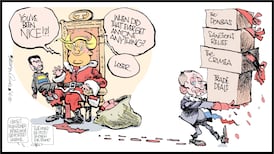Last weekend I binged out on sport. As someone with Catholic tastes I’ll watch anything, and live sports have always appealed to me. On a positively balmy Friday night at the Tallaght Stadium, Shamrock Rovers and Sligo offered up a thrilling game: football played on the ground, as it should be, to a packed house. (Rovers grabbed the points.) The League of Ireland’s resurrection continues – gates are rising, fans are committed and people who might be alienated by the juggernaut of the Premiership have something local to sing about.
The following day nearly 50,000 turned up at the Aviva to witness rugby of the finest standard. Although only a few miles apart in south Dublin, the sociological contrast between the two sets of fans could probably be the basis of a thesis in itself; Irish football has always been Irish rugby’s poorer cousin.
Whatever about the welcome green shoots of the League of Ireland, rugby on this island has never been healthier. Ireland is gripped by “rugbymania”. Not only are the national team number one in the world, but, in what was seen by many as an Ireland versus France showdown at the Aviva, the result went unambiguously to the home team. Leinster hammered Toulouse.
The national team are Grand Slam champions, but, critically, so are the under-20s. If the youngsters are at the top of their game, those players should progress on to maturity and an all-beating under-20s team indicates good times ahead. Without tempting fate, the 2020s could be Ireland’s rugby decade in the way the 1970s was for Wales.
READ MORE
Betting this trend will continue, a €30 million rugby experience museum opened this week in Limerick – a reminder to anyone getting carried away with all this Leinster cheerleading that while Munster might be struggling today, its claim over Irish rugby remains strong. If you doubt the rivalry, expect many in red to be rooting for La Rochelle in yellow. The Ronan O’Gara factor adds spice to an already fiery dish.
Ireland’s success in rugby is all the more impressive given that so few play the game compared with GAA or football. Today Ireland’s rugby academies, in Dublin in particular, are overflowing with talented teenagers. It’s impossible to get a place. Demand is surging and the wealth of talent coming through the school system, according to the aficionados (of which exhaustingly rugby has many), has never been seen before.
But who are these kids? Why are so many of them emerging as teenage rugby sensations? And why now? They’re referred to in rugby circles as the “SSIA Babies”, so let’s go back a bit to the genesis of Ireland’s rugby renaissance. In the beginning, there was a saving scheme!
The choices people make around having children are complex and deeply personal, but there is a statistical reality and observable trend: having babies is to some extent correlated with prosperity, or at least better expectations about the future. In general, as societies get richer, people tend to have fewer children, but once the birth rate reaches a certain plateau we see that couples who are feeling confident about the future will have more children. All this makes sense. Children are expensive. The classic example of this link between children and perception of the future is the collapse of the birth rate in the former Soviet societies of eastern Europe after the trauma of the fall of communism.
While young couples in eastern Europe were suffering, in the far west of Europe we were positively euphoric. At the height of the Celtic Tiger group-trip, then minister for finance and ex-Kildare TD Charlie McCreevy introduced a short-term wheeze to try to take money out of the economy. About 40 per cent of the adult population, 1.1 million people, opened Special Savings Incentive Accounts (SSIAs) that matured between 2006 and 2007. The five-year scheme gave individuals the opportunity to gain tax credit from their savings. (A €100 monthly lodgement would entitle you to €25 tax credit.) Of course, there were many other factors driving the economic boom of the mid-2000s, but SSIAs were a significant contributor. At maturity the SSIAs released €16 billion into the economy.

This free money cascaded into an already overheating economy, driving people into a frenzy. Apart from second houses in Bulgaria, another frenzy was a frenzy of fecundity. Between 2005 and 2006, in the McCreevy windfall, 65,425 babies were born. This increased to 71,389 in 2007, the largest number of babies born in Ireland in any year for a century.
Of these youngsters 40,590 were born in Leinster. As the SSIA continued to drive us on in 2008 a total of 75,173 babies arrived. Leinster topped the tables again in 2008, accounting for 42,436 babies or 56 per cent of the whole country.
In the traditional rugby stronghold of south Dublin, 4,700 babies were born or 6.21 per cent of total births in the State. Although grassroots rugby is changing, “the goys” are still in the ascendancy. Of the 15 players who played in the Grand Slam decider against England on March 18th, nine were produced by fee-paying south Dublin schools.
Years ago I wrote in my book The Pope’s Children about the trend for pupils from south Dublin schools to reproduce with each other, a wedding fusion of Blackrock and Mount Anville. (Ross O’Carroll-Kelly might say less a marriage, more of a strategic management buyout, promoting the winning DNA, with great teeth and muscular limbs.)
The future of Irish rugby is safe, the production line is humming. The SSIA babies are out there now, pushing for places in the next under-20s squad, eyes on the coveted jersey, future Gary Ringroses in the making. Who would have thought that Charlie McCreevy, a GAA obsessive who once declared that Kildare beating Kerry was “better than sex”, was the man to thank for all this?













